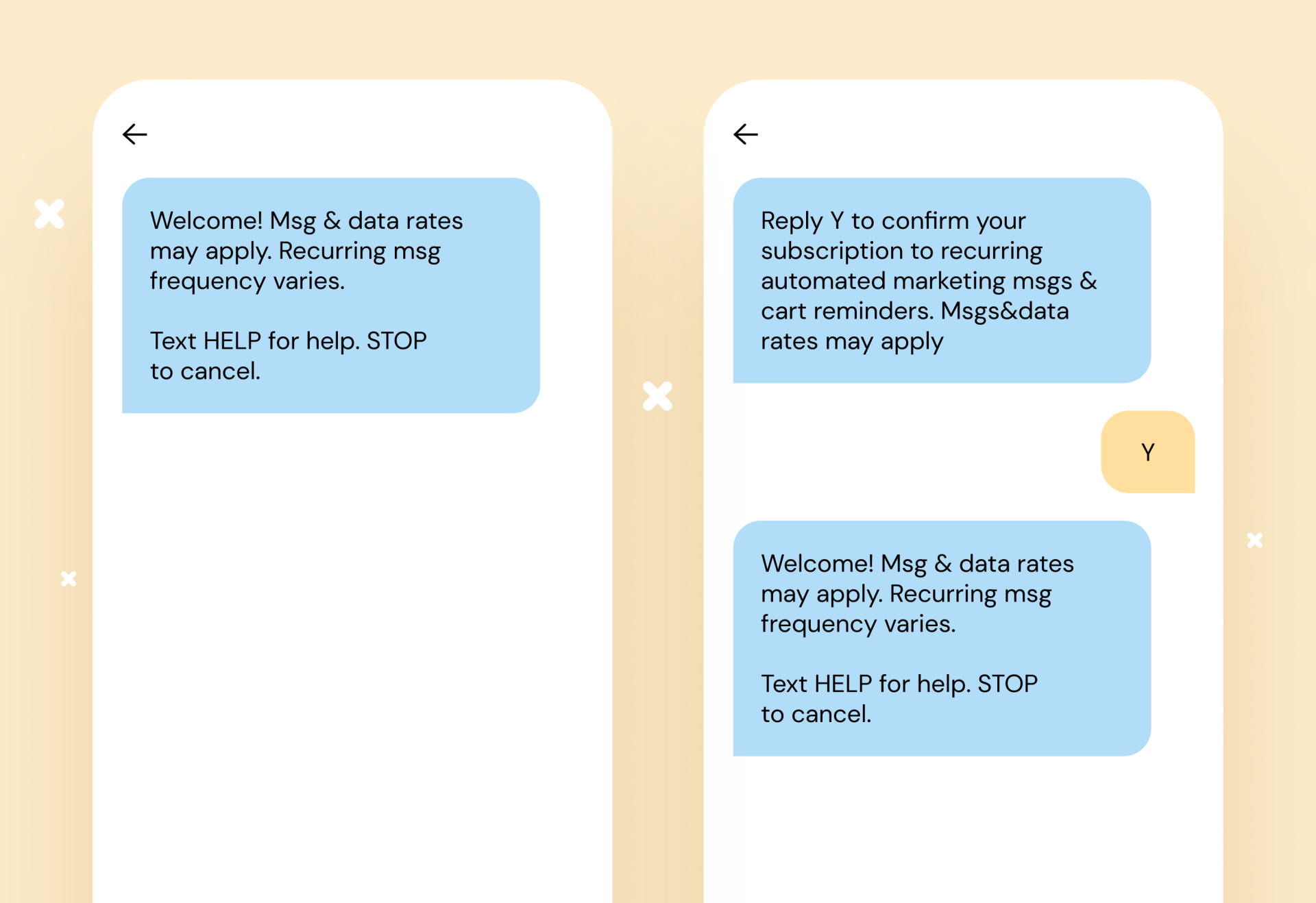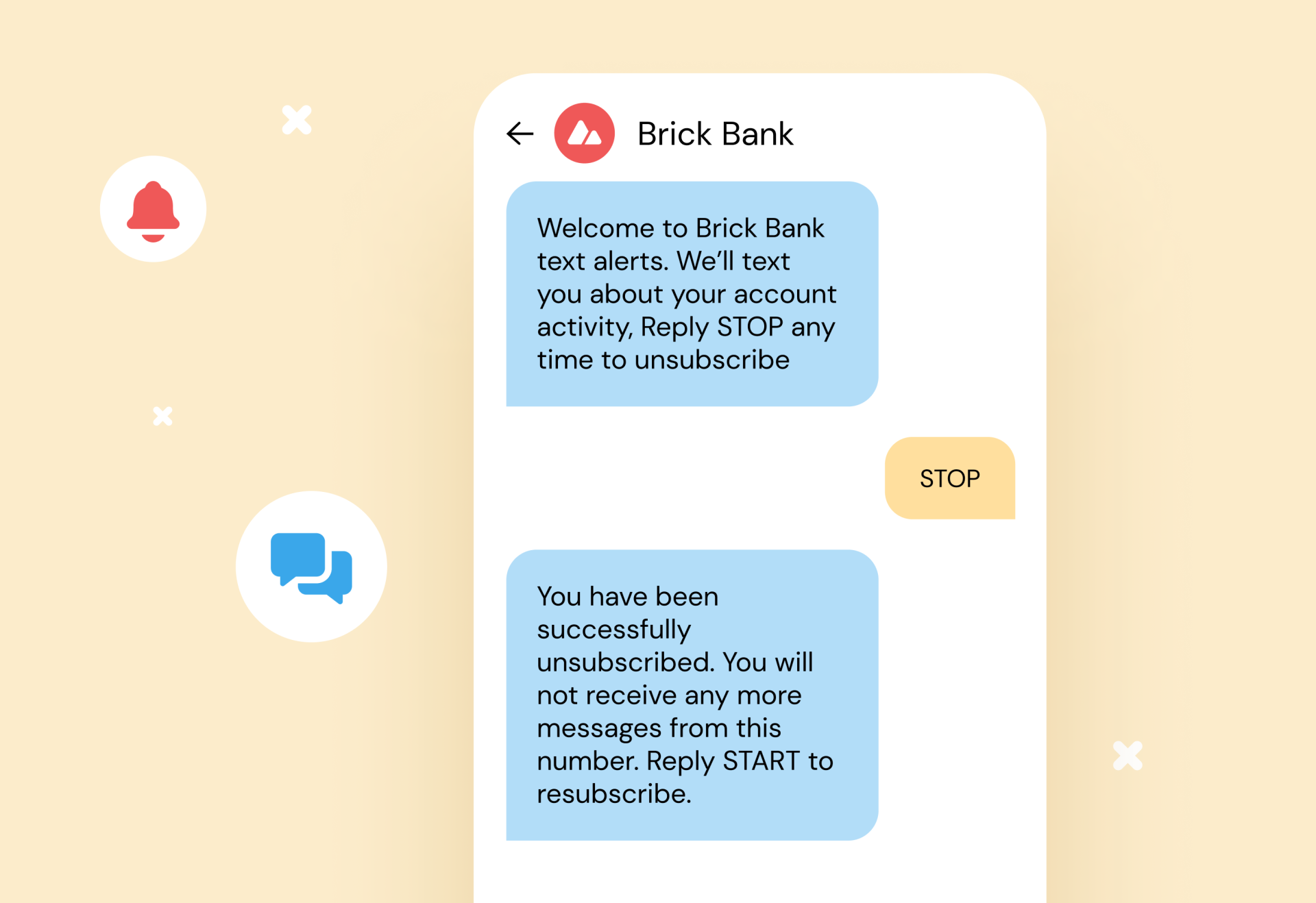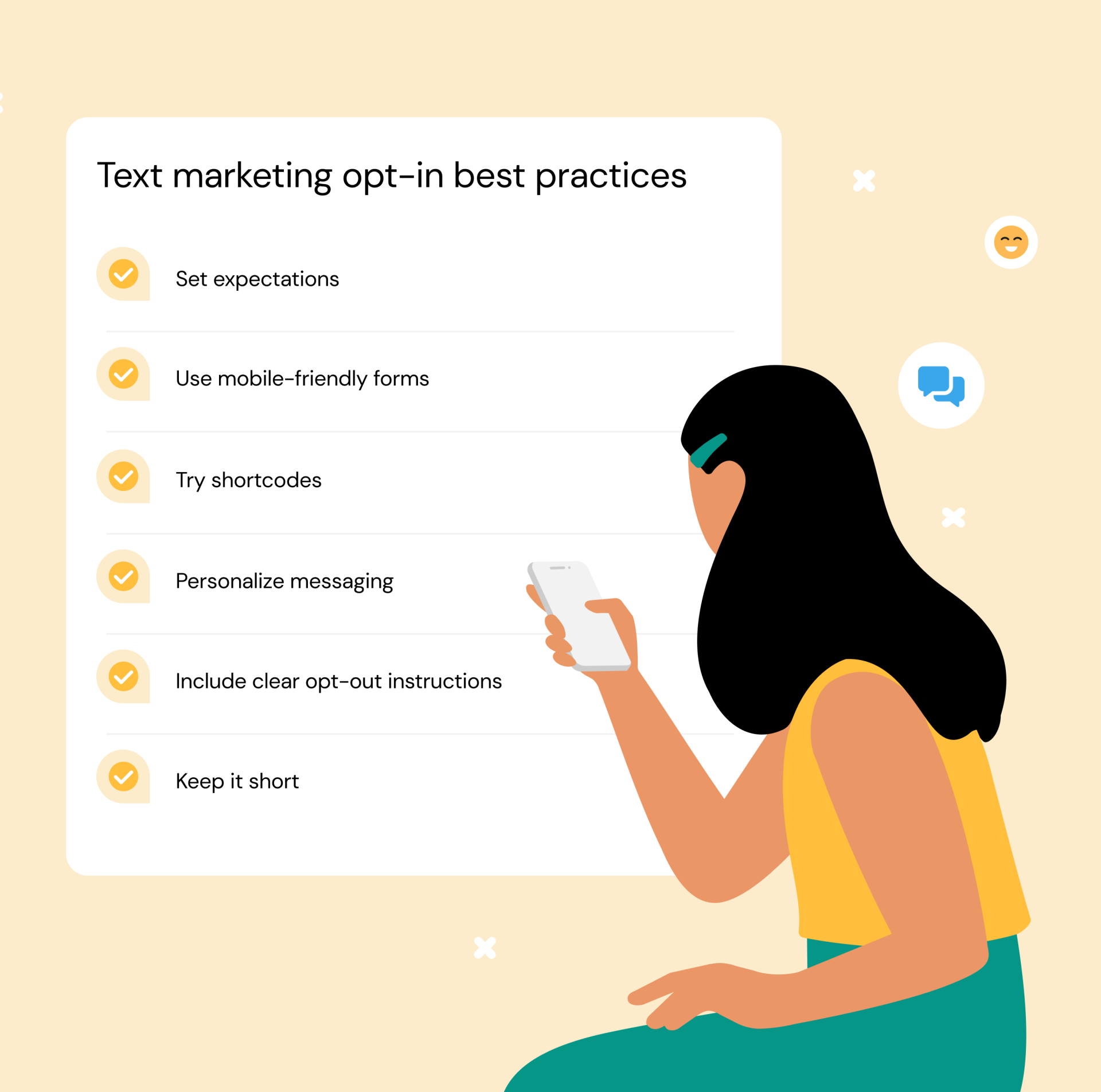Email marketing has been around a while, but SMS marketing is quite a bit younger, and many companies and marketers are still in the process of normalizing their usage of it. But consumers who opt in for SMS love receiving texts from companies.
The primary advantage of SMS marketing is that nearly everyone on your list sees everything you send out. For things like reminders, time-limited offers, and transactional confirmations, you can be almost certain your subscribers will see these messages within minutes of when you send them.
The open rate for SMS messages is about 98%. Because texts are so short, and because most people carry their phones all the time and get notified when a text has arrived, they’ve been trained to open and read SMS messages as they come in. And most people do.
To engage your customers in places where they’ll see and respond to your messages, start by growing your SMS list. That begins by creating an SMS opt-in campaign.
In this article, we’ll look at how to get more SMS opt-ins so you can grow your list and use this highly effective and low-cost marketing channel to achieve more of your marketing goals.
What is SMS opt-in?
An SMS opt-in is an offer to a potential subscriber or existing customer to join your SMS list and receive marketing messages, alerts, and reminders from your company via text message.
There are three types of SMS opt-in procedures – single opt-in, double opt-in, and soft opt-in. Here’s a brief summary of each:
- Single opt-in: A consumer joins your SMS list and is instantly added with no confirmation.
- Double opt-in: A consumer requests to join your SMS list, and receives a confirmation opt-in text message that lets them verify that they want to join. This also confirms, for the company, that the phone number given is a real one.
- Soft opt-in: You offer your existing contacts – usually via email – the chance to join your SMS list, too. You already have some of their contact information and they’re used to hearing from you. You’re just giving them the option to add another way for you to reach them.

An example of a single opt-in text message (left) and a double opt-in SMS message (right).
Why is SMS opt-in important?
Having an SMS marketing list is a huge business asset, but it’s very important that the people on your list have signaled they want to be there. Email compliance is certainly more strict these days than it was ten years ago. But SMS compliance is far more strict.
Sending unsolicited text messages can lead to big fines if people start to complain. This is partly because mobile carriers use different technology than internet providers, and don’t want their networks clogged with spam. Plus, an SMS inbox is a more personal place than an email inbox.
Customers don’t want spam in their SMS inboxes. So by letting them opt in to your SMS list, and making it easy to opt out, you build trust with those on your subscriber list.
Because everyone has opted in, you can be confident that they all want to hear from you.
What is SMS opt-out?
Just like with email, you need to make it easy for people to get off your SMS list if they no longer want to hear from you. If you’re on any SMS lists of other companies, you already know how this works. You simply add a short message at the end of each text saying that they can text STOP if they want to stop receiving SMS messages from your company.
A few ways you could phrase this include:
-
Text STOP to unsubscribe
-
Reply STOP to unsubscribe
-
Reply END to stop receiving messages
-
To stop receiving our texts, reply END
SMS marketing is becoming more and more common. Most marketers use similar opt-out language and consumers know what to expect. So there’s no need to use too many characters to describe your SMS opt-out process.
Offering an opt-out option is a requirement in many countries. So this isn’t something you can just leave out.

We recommend that every text you send should contain clear opt-out instructions.
Complying with SMS opt-in rules and requirements
We’re not legal experts (and this isn't legal advice), so you should consult with your own independent counsel or legal team before starting any new marketing program.
This is an important thing to do because SMS communications in the United States are governed by the Telephone Consumer Protection Act (TCPA), which dates all the way back to 1981. Its number one requirement for SMS opt-in procedures is clear:
Explicit consent
It’s required to obtain explicit consent from a new subscriber that they want to receive texts from your company.
Again, there are fines if you can’t prove consent has been given. Those fines range from $500 to $1500. So in addition to only messaging people who have provided consent, keep a record of when and how people gave that consent.
Other information to make clear up front
The TCPA also stipulates that your SMS opt-in form must clearly state a few pieces of information:
- How frequently your recipients can expect to receive texts from your company
- The purpose of your messages
- The phrase “Msg and data rates may apply”
- Links to your terms and conditions, and your privacy policy
- Instructions for how to opt-out
Additionally, if you're using 10DLC messaging to send SMS, you'll need to make sure you're following all the right steps to ensure your brand is registered to send A2P 10DLC.
How often should you send marketing texts? Again, SMS isn't like email. People don’t want to be texted every day. Even a few times per week is pushing it. Once a week, or a couple times a month, is a safer pace for SMS, excluding things like automated reminders and confirmations.
All that should be in your form, and you should also include this information again in your welcome text.
Consider time zones (and quiet hours)
Remember that with SMS, many people have audible notifications on their phones any time a text message arrives. So take note of the time zones of your SMS subscribers, and avoid sending messages too late at night or too early in the morning.
Check with the suits
Before getting started with your SMS marketing campaigns, check with local regulations, business policies, and your legal team, just to be sure you aren’t ignoring any requirements. For U.S. companies, see our SMS compliance guide for information about privacy laws, carrier expectations, and more.
Text marketing opt-in best practices
How you market your SMS list will vary based on context. If you have in-store clerks talking about your store's promotional SMS campaign with customers as they pay for items, that clerk probably isn’t going to go through all the legal requirements listed above. That’s one reason to put it all in your welcome text.
But you might want to create a small brochure that has all that information too, if you have brick and mortar locations.
For other businesses, whenever you market your SMS list, try to do all of the following as part of your opt-in process:
Set expectations
This is the fun part. Clearly communicate the benefits of joining your SMS list. They’ll get updates, insider information, special offers, and they’ll be the first to know when something new and exciting is happening. And as mentioned earlier, tell them about how often you’ll send messages, and that opting out is super easy.
Use mobile-friendly forms
SMS is a mobile service, so make sure your opt-in form works on mobile.
Try shortcodes
Shortcodes are 5-digit numbers (sometimes 6) that companies use to make it easy for subscribers to respond to offers. For example, “text SANTA to 44444 to claim your holiday discount”, or “text WIN to 33333 to enter the contest.”
You can also use shortcodes to make it easy to join your SMS list in the first place – “text JOIN to 55555 to receive texts from us.” Here’s more about shortcodes and the benefits of using them.
Personalize messaging
Just like with email, you can insert personalized information in texts using dynamic fields. You should look to do this as often as appropriate. If you’re sending a campaign to a particular region, city, or state, you might be able to fit that into your SMS copy. You can also add names, companies, past purchase dates, and lots of other personalized information.
People like feeling known and being treated special, and personalized marketing is a great way to do this with SMS!
You can also personalize by list segment (similar to what you might do with email segmentation). You may have some subscribers who are interested in certain products or services, and others who prefer different ones. By segmenting your list, you can speak to each subscriber with more relevance to their lives and interests.
Include clear opt-out instructions
This was mentioned earlier but it bears repeating. Put opt-out instructions in your SMS opt-in marketing, and in your welcome text message. After that, you should include an opt-out option in all of your SMS messages.
Keep it short
Text messages are character limited, so this isn’t the place to go on and on about… anything. Your messages should state the offer, give a CTA and a link or other method of response, and that’s it.
The more detailed information related to any offer belongs on whatever landing page the link in the message will take them to. The text just has to make them want it enough to click.
This is why SMS marketing is ideal for people who already know, like, and trust your brand.

Timely text message marketing can drive quick customer attention and action.
How to increase SMS opt-ins
Asking your email subscribers if they want to receive SMS from your brand is one way to grow your SMS marketing list. But even for them, giving out their phone number will feel different than giving out their email. Phone numbers are a bit more personal.
Here are a few ways to increase your SMS opt-in rates.
Offer an incentive
This is the most effective approach to motivate people to join your SMS list. Offer them a special discount, free gift, coupon, or other sort of immediate benefit to joining.
To decrease opt-outs and motivate people to remain on your list longer, your incentives could include annual specials, rewards points accrual bonuses, and other repeating or accumulating benefits.
Ready to get started with sending promotional text messages? Check out our list of 20+ promotional text message examples and templates for different kinds of marketing campaigns.
Multi-channel promotion
We’ve already mentioned email as probably the most effective place to go to market your SMS list. But don’t stop there. You can also push your SMS list benefits on all your social media platforms.
And as mentioned before, if you have physical stores, have brochures, banners, posters, and other in-store visuals promoting your SMS list. Train your staff to offer this to customers.
If you do any print advertising, it’s easy to fit a little SMS opt-in offer on a postcard or sales letter. And if you run TV ads, you can also include this as a graphic on your ad, which is a great way to increase the measurable effect of TV – and this includes streaming and other digital video and display ads.
You can also feature your SMS list on your website homepage, banners, and other key areas, such as your checkout and thank you pages. Those moments are when customers feel their most positive feelings about your company. So why not offer them a chance to stay in touch via SMS?
Website popups
Popups may have a reputation of being “annoying,” but they work. They often work better as delayed popups. But you can test the various approaches. The point is – offer your SMS list in a popup, and include the incentive to be sure to get their attention.
Text-to-join SMS keywords
No matter where you’re promoting your SMS list, text-to-join keywords, like those mentioned earlier, make it much easier to subscribe to your SMS list.
And the more fun you make these words, the better. Instead of “text JOIN to receive text messages from us,” say something like, “text SURPRISE to claim your discount!”
The more creative and unique the SMS keyword is to your brand, the better.
Get started with your SMS opt-in campaign
Email sometimes goes to spam. You can overcome that, but it’s work. Text message marketing offers a way to communicate directly with customers who have already said they want to hear from you, and you know that they’ll all see your messages. SMS has no spam folder.
With SMS added to your other marketing efforts, you will increase conversions and boost revenue, in addition to gaining and keeping the trust of your customers.
Want to learn more about conversational marketing and how to get started on a campaign that hits on all points of the customer journey? See our five best examples.
When you’re ready to talk about SMS or conversational marketing, speak to a Sinch expert and see what’s possible.



